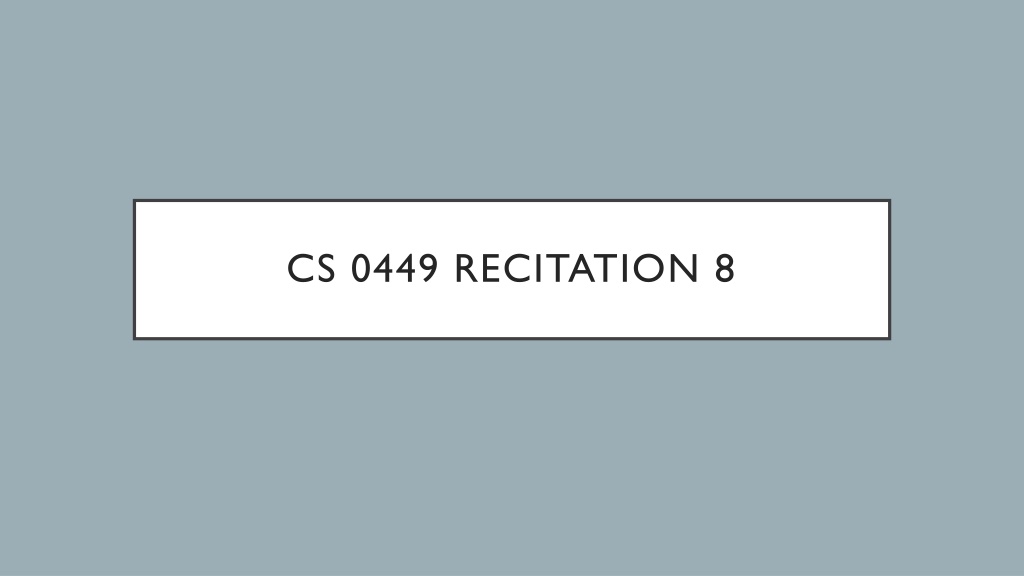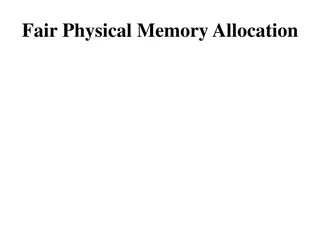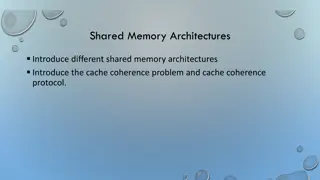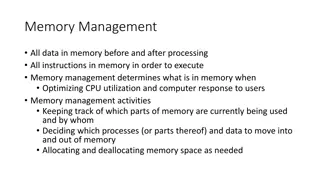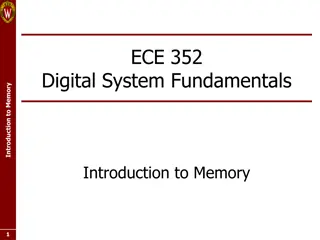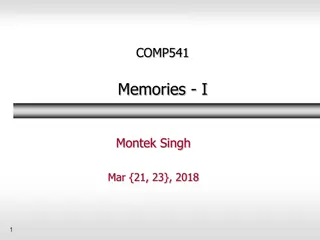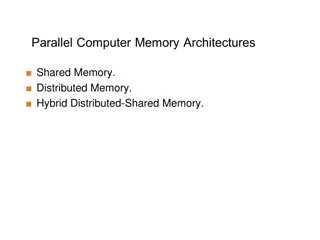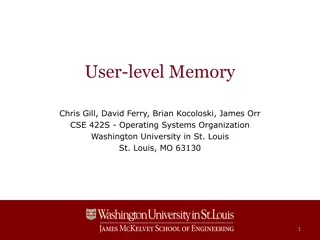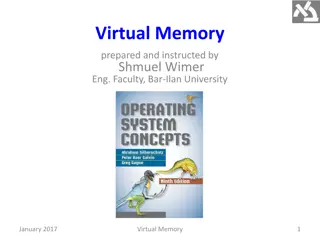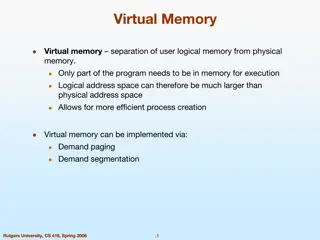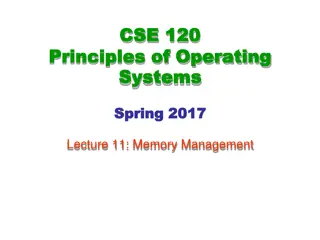Memory Management in Operating Systems
Dive into the world of memory management in operating systems, covering topics such as virtual memory, page replacement algorithms, memory allocation, and more. Explore concepts like memory partitions, fixed partitions, memory allocation mechanisms, base and limit registers, and the trade-offs between different memory characteristics. Improve your understanding of how memory is managed in the ideal world versus reality, aiming to bridge the gap for optimal system performance.
Download Presentation

Please find below an Image/Link to download the presentation.
The content on the website is provided AS IS for your information and personal use only. It may not be sold, licensed, or shared on other websites without obtaining consent from the author.If you encounter any issues during the download, it is possible that the publisher has removed the file from their server.
You are allowed to download the files provided on this website for personal or commercial use, subject to the condition that they are used lawfully. All files are the property of their respective owners.
The content on the website is provided AS IS for your information and personal use only. It may not be sold, licensed, or shared on other websites without obtaining consent from the author.
E N D
Presentation Transcript
LOGISTICS To be covered today: 1) Virtual Memory 2) Page Replacement Algorithms 3) Paging & Page Tables 4) Memory Allocation Algorithms 5) Live coding LRU eviction in Java
REMEMBER FROM LAST TIME The ideal world has memory that is 1) Copious in Supply 2) Very Fast 3) Non-volatile But the reality is that we can only pick two of the following: 1) Copious Memory 2) Fast Memory 3) Affordable Memory Goal: Get the real world as close as possible to the ideal world!
FIXED PARTITIONS Idea: 1. Divide memory into fixed spaces 2. Each process will be assigned a fixed space when it s free Mechanisms: 1. Separate input queues for each partition 2. Single input queue: has better ability to optimize CPU usage
WHATS THE DIFFERENCE HERE? On the right side, with individual input queues for each partition, we can easily determine with partition to put a process in. Downside is overhead. On the left side, if we have a single input queue, we will use less memory, but it will take longer to identify which partition to assign a process to.
BASE AND LIMIT REGISTERS Special CPU registers: base & limit 1. Access to the registers limited to system mode 2. Registers contain: Base: start of the process s memory partition Limit: length of the process s memory partition Address generation 3. Physical address: location in actual memory Logical address: location from the process s point of view Physical address = base + logical address Logical address larger than limit => error
AN EXAMPLE First, what does this diagram represent? 1. The processes that are allocated on the OS! If we have a logical address of 0x1204, we can Calculate the Physical Address like so: Physical address = base + logical address 0x1204 + 0x9000 = 0xa204
SWAPPING Memory allocation changes as: 1. Processes come into memory 2. Processes leave memory
SWAPPING We need to allow for programs to grow. Allocate more memory for data Meaning a larger stack This is handled by allocating more space than necessary at the start But this is inefficient: it will waste memory that s not currently in use.
TRACKING MEMORY USAGE: BITMAPS Keep track of free / allocated memory regions with a bitmap One bit in map corresponds to a fixed-size region of memory Bitmap is a constant size for a given amount of memory regardless of how much is allocated at a particular time Chunk size determines efficiency 1. At 1 bit per 4KB chunk, we need just 256 bits (32 bytes) per MB of memory 2. For smaller chunks, we need more memory for the bitmap 3. Can be difficult to find large contiguous free areas in bitmap
TRACKING MEMORY USAGE: LINKED LISTS Keep track of free / allocated memory regions with a linked list 1. Each entry in the list corresponds to a contiguous region of memory 2. Entry can indicate either allocated or free (and, optionally, owning process) 3. May have separate lists for free and allocated areas Efficient if chunks are large 1. Fixed-size representation for each region 2. More regions => more space needed for free lists
ALLOCATING MEMORY Search through region list to find a large enough space Suppose there are several choices: which one to use? 1. First fit: the first suitable hole on the list 2. Next fit: the first suitable after the previously allocated hole 3. Best fit: the smallest hole that is larger than the desired region (wastes least space?) 4. Worst fit: the largest available hole (leaves largest fragment) Option: maintain separate queues for different-size holes
FREEING MEMORY 1. Allocation structures must be updated when memory is freed 2. Easy with bitmaps: just set the appropriate bits in the bitmap 3. Linked lists: modify adjacent elements as needed Merge adjacent free regions into a single region May involve merging two regions with the just-freed area
PROBLEMS WITH SWAPPING 1. Process must fit into physical memory (impossible to run larger processes) 2. Memory becomes fragmented External fragmentation: lots of small free areas Compaction needed to reassemble larger free areas 3. Processes are either in memory or on disk: half and half doesn t do any good
THE MOTIVATION Physical memory is a scarce resource! Basic Idea: We want to allow the OS to hand out more memory than exists on the system! Keep recently used stuff in Physical Memory Move least recently used stuff to Disk But keep this information hidden from processes Processes will still see an address space from 0 max address The addresses each process accesses is not the real address sent to memory Movement of information to and from disk is handled by the OS
VIRTUAL AND PHYSICAL ADDRESSES Programs use virtual addresses Addresses local to the process Hardware translates virtual addresses to physical addresses
ENTER THE MEMORY MANAGEMENT UNIT (MMU) The translation from virtual address to physical address is done by the Memory Management Unit It is typically on the same chip as the CPU Only physical addresses leave the CPU/MMU schip Physical memory is indexed by physical addresses
PAGING AND PAGE TABLES Virtual addresses are mapped to physical addresses A unit of mapping is called a page (Typically 4KiB) All addresses in the same virtual page are in the same physical page A Page Table Entry (PTE) contains translation for a single page. Page Table translates virtual page number to a physical page number Not all virtual memory has a physical page Not every physical page needs to be used
EXAMPLE Consider a 64KB virtual address space and a 32 KB physical memory: Where would a Page whose lives at 17 KB in the virtual address space map to in Physical memory? This looks like a prime candidate for a certain data structure can anyone name it?
WHATS IN A PAGE TABLE ENTRY? Each entry in the page table contains: 1) Valid bit: set if this logical page number has a corresponding physical frame in memory If not valid, remainder of PTE is irrelevant 2) Page frame number: page in physical memory 3) Referenced bit: set if data on the page has been accessed 4) Dirty (modified) bit: set if data on the page has been modified 5) Protection information
MAPPING LOGICAL TO PHYSICAL ADDRESSES Split address from CPU into two pieces: 1) Page number (p) 2) Page offset (d) Page Number: 1) Index into the page table 2) Page table contains the base address of page in physical memory Page Offset 1) Added to base address to get actual physical memory address Page Size = 2?
EXAMPLE 4KB (4096 B) pages 32 bit logical addresses 2?= 4096 ? = 12 ???? 32 12 = 20 ????
ADDRESS TRANSLATION ARCHITECTURES & PAGING STRUCTURES
TWO-LEVEL PAGE TABLES Problem: page tables can be too large 232bytes in 4KB pages need 1 million PTEs Solution: use multi -level page tables Page size in first page table is large (megabytes) PTE marked invalid in first page table needs no 2nd level page table 1st level page table has pointers to 2nd level page tables 2nd level page table has actual physical page numbers in it
MORE ON TWO-LEVEL PAGE TABLES 1) Tradeoffs between 1st and 2nd level page table sizes Total number of bits indexing 1st and 2nd level table is constant for a given page size and logical address length Tradeoff between number of bits indexing 1st and number indexing 2nd level tables More bits in 1st level: fine granularity at 2nd level Fewer bits in 1st level: maybe less wasted space? 2) All addresses in table are physical addresses 3) Protection bits kept in 2nd level table
TWO-LEVEL PAGING EXAMPLE System characteristics: 8 KB pages 32-bit logical address divided into:13 bit page offset, 19 bit page number Page number divided into: 10 bit page number 9 bit page offset Logical address looks like this: p1 is an index into the 1st level page table p2 is an index into the 2nd level page table pointed to by p1
TWO-LEVEL ADDRESS TRANSLATION EXAMPLE
IMPLEMENTING PAGE TABLES IN HARDWARE 1) Page table resides in main (physical) memory 2) CPU uses special registers for paging Page table base register (PTBR) points to the page table Page table length register (PTLR) contains length of page table: restricts maximum legal logical address 3) Translating an address requires two memory accesses First access reads page table entry (PTE) Second access reads the data / instruction from memory 4) Reduce number of memory accesses Can t avoid second access (we need the value from memory) Eliminate first access by keeping a hardware cache (called a translation lookaside buffer or TLB) of recently used page table entries
ENTER TLB (SOUNDS LIKE DLB :P) 1) Search the TLB for the desired logical page number (Sounds cachey ) Search entries in parallel Use standard cache techniques 2) If desired logical page number is found, get frame number from TLB 3) If desired logical page number isn t found Get frame number from page table in memory Replace an entry in the TLB with the logical & physical page numbers from this reference
HANDLING TLB MISSES 1) If PTE isn t found in TLB, OS needs to do the lookup in the page table 2) Lookup can be done in hardware or software 3) Hardware TLB replacement CPU hardware does page table lookup Can be faster than software Less flexible than software, and more complex hardware 4) Software TLB replacement OS gets TLB exception Exception handler does page table lookup & places the result into the TLB Program continues after return from exception Larger TLB (lower miss rate) can make this feasible
ENTER INVERTED PAGE TABLES 1) Reduce page table size further: keep one entry for each frame in memory 2) PTE contains: Virtual address pointing to this frame Information about the process that owns this page 3) Search page table by: Hashing the virtual page number and process ID Starting at the entry corresponding to the hash result Search until either the entry is found or a limit is reached 4) Page frame number is index of PTE 5) Improve performance by using more advanced hashing algorithms
MOTIVATION FOR PAGE REPLACEMENT ALGORITHMS 1) Page Fault forces a choice What is a Page Fault? We don t have room in our Page Table for another page!! We don t have room for a new page (steady state) Which page must be removed to make room for an incoming page? 2) How is a page removed from physical memory? If the page is unmodified, simply overwrite it: a copy already exists on disk If the page has been modified, it must be written back to disk: prefer unmodified pages? We had a certain field in our PTEs that reflected this, can anyone name it? The Dirty Bit! 3) Better not choose an often used page Will likely need to brough back in soon
PAGE REPLACEMENT ALGORITHMS We will go over the following: 1) Optimal Page Replacement Algorithm 2) Not-Recently-Used (NRU) Algorithm 3) First In First Out (FIFO) Algorithm 4) Second Chance Algorithm 5) Least Recently Used (LRU) Algorithm
OPTIMAL PAGE REPLACEMENT What s the best we can possibly do? Assume perfect knowledge of the future Not realizable in practice (usually) Useful for comparison: if another algorithm is within 5% of optimal, not much more can be done Algorithm: replace the page that will be used furthest in the future Only works if we know the whole sequence! Can be approximated by running the program twice Once to generate the reference trace Once (or more) to apply the optimal algorithm Nice, but not achievable in real systems!
THE ASSUMPTION Since it is a 32-bit address space. First 20 bits is used for theaddress The rest is used for offset Page Address PageOffset l 190a7c20 s 3856bbe0 l 190afc20 l 15216f00 l 190a7c20 l 190a7c28 l 190a7c28 l 190aff38
OPTIMAL PAGE REPLACEMENT EXAMPLE Let's suppose you have 12KB of physical memory Page has 4KB Assume OPT l 190a7c20 s 3856bbe0 l 190afc20 l 15216f00 l 190a7c20 l 190a7c28 l 190a7c28 l 190aff38 0 1 2
OPTIMAL PAGE REPLACEMENT EXAMPLE Let's suppose you have 12KB of physical memory Page has 4KB Assume OPT You already know memory access trace at the beginning l 190a7c20 s 3856bbe0 l 190afc20 l 15216f00 l 190a7c20 l 190a7c28 l 190a7c28 l 190aff38 0 1 2
